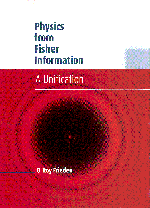Book contents
- Frontmatter
- Contents
- 0 Introduction
- 1 What is Fisher information?
- 2 Fisher information in a vector world
- 3 Extreme physical information
- 4 Derivation of relativistic quantum mechanics
- 5 Classical electrodynamics
- 6 The Einstein field equation of general relativity
- 7 Classical statistical physics
- 8 Power spectral 1/f noise
- 9 Physical constants and the 1/x probability law
- 10 Constrained-likelihood quantum measurement theory
- 11 Research topics
- 12 Summing up
- Appendix A Solutions common to entropy and Fisher I-extremization
- Appendix B Cramer–Rao inequalities for vector data
- Appendix C Cramer–Rao inequality for an imaginary parameter
- Appendix D Simplified derivation of the Schroedinger wave equation
- Appendix E Factorization of the Klein–Gordon information
- Appendix F Evaluation of certain integrals
- Appendix G Schroedinger wave equation as a non-relativistic limit
- Appendix H Non-uniqueness of potential A for finite boundaries
- References
- Index
10 - Constrained-likelihood quantum measurement theory
Published online by Cambridge University Press: 30 January 2010
- Frontmatter
- Contents
- 0 Introduction
- 1 What is Fisher information?
- 2 Fisher information in a vector world
- 3 Extreme physical information
- 4 Derivation of relativistic quantum mechanics
- 5 Classical electrodynamics
- 6 The Einstein field equation of general relativity
- 7 Classical statistical physics
- 8 Power spectral 1/f noise
- 9 Physical constants and the 1/x probability law
- 10 Constrained-likelihood quantum measurement theory
- 11 Research topics
- 12 Summing up
- Appendix A Solutions common to entropy and Fisher I-extremization
- Appendix B Cramer–Rao inequalities for vector data
- Appendix C Cramer–Rao inequality for an imaginary parameter
- Appendix D Simplified derivation of the Schroedinger wave equation
- Appendix E Factorization of the Klein–Gordon information
- Appendix F Evaluation of certain integrals
- Appendix G Schroedinger wave equation as a non-relativistic limit
- Appendix H Non-uniqueness of potential A for finite boundaries
- References
- Index
Summary
Introduction
In preceding chapters, EPI has been used as a computational procedure for establishing the physical laws governing various measurement scenarios. We showed, by means of the optical measurement model of Sec. 3.8, that EPI is, as well, a physical process that is initiated by a measurement. Specifically, it arises out of the interaction of the measuring instrument's probe particle with the object under measurement. This perturbs the system probability amplitudes, which perturbs the informations I and J, etc., as indicated in Figs. 3.3 and 3.4. The result is that EPI derives the phenomenon's physics as it exists at the input space to the measuring device.
We also found, in Sec. 3.8, the form of the phenomenon's physics at the output to the measuring instrument. This was given by Eq. (3.51) for the output probability amplitude function.
The analysis in Sec. 3.8 was, however, severely limited in dimensionality. A One-dimensional analysis of the measurement phenomenon was given. A full, covariant treatment would be preferable, i.e., where the space-time behavior of all probability amplitudes were determined.
Such an analysis will be given next. It constitutes a covariant quantum theory of measurement. This covariant theory will be developed from an entirely different viewpoint than that in Sec. 3.8. The latter was an analysis that focussed attention upon the probe-particle interaction and the resulting wave propagation through the instrument. The covariant approach will concentrate, instead, on the meaning of the acquired data to the observer as it reflects upon the quantum state of the measured particle.
- Type
- Chapter
- Information
- Physics from Fisher InformationA Unification, pp. 235 - 253Publisher: Cambridge University PressPrint publication year: 1998



